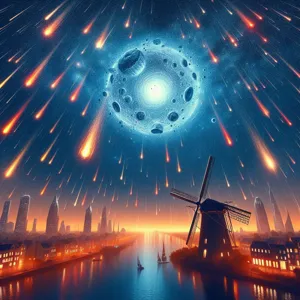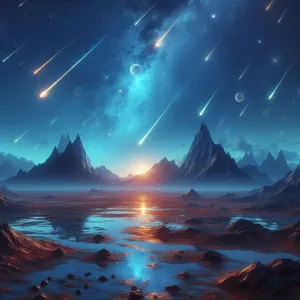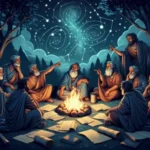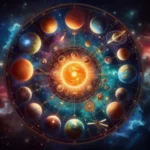As the sun dips below the horizon and darkness cloaks the earth, our gaze often turns skyward, yearning for the beauty of the cosmos.
Among nature’s most breathtaking displays are meteor showers—a celestial phenomenon that transforms the night sky into a dazzling array of shooting stars. Each year, these astronomical events invite stargazers and dreamers alike to witness the remnants of comets and asteroids blazing through our atmosphere, leaving behind captivating trails of light. In this blog post, we will embark on a journey through the various types of meteor showers, exploring their origins, peak viewing times, and the unique characteristics that make each one a spectacular event. Whether you’re a seasoned astronomer or a curious newcomer, join us as we delve into the enchanting world of celestial spectacles, where the universe puts on a show that is sure to inspire wonder and awe.
1. Introduction to Meteor Showers

Meteor showers are one of the most captivating celestial events we can witness from Earth, offering a mesmerizing display of shooting stars that streak across the night sky. These natural phenomena occur when our planet passes through streams of debris left behind by comets or asteroids, which burn up upon entering the Earth’s atmosphere, creating brilliant flashes of light. While individual meteors can be seen at any time of the year, meteor showers are specific events that happen at predictable intervals, often tied to the orbit of a particular celestial body.
Each meteor shower is unique, showcasing distinct characteristics that make them special. Some showers are known for producing bright, fast meteors, while others may offer a more modest display with slower, longer-lasting trails. These events are typically named after the constellation from which they appear to originate; for instance, the Perseids emanate from the constellation Perseus, while the Geminids radiate from Gemini.
Meteor showers can evoke a sense of wonder and excitement, drawing stargazers, amateur astronomers, and nature enthusiasts alike to open fields and dark skies in hopes of catching a glimpse of the dazzling display. Whether you’re an experienced skywatcher or a curious newcomer, understanding the different types of meteor showers and their peak viewing times can enhance your experience, making your night under the stars truly unforgettable. In the sections that follow, we’ll explore the most prominent meteor showers, their origins, and tips for optimal viewing—so get ready to witness the universe’s spectacular light show!
2. What Causes Meteor Showers?
Meteor showers are one of nature’s most captivating phenomena, offering a dazzling display of shooting stars that ignite the night sky. But have you ever wondered what causes these celestial events? At their core, meteor showers occur when Earth passes through the debris left behind by comets or asteroids. As these cosmic wanderers travel through space, they shed particles—tiny grains of dust and ice—that become entrained in their orbits.
When Earth crosses these orbits during its annual journey around the sun, the particles collide with our atmosphere at staggering speeds, often exceeding 40,000 miles per hour. This rapid entry creates friction, heating the particles to the point of incandescence, resulting in the brilliant streaks of light we know as meteors. Depending on the density and size of the debris, the intensity and frequency of the meteor shower can vary dramatically.
Meteor showers are typically categorized by the parent body that contributes to the debris field. For instance, the Perseids, one of the most popular meteor showers, are associated with the comet Swift-Tuttle, while the Geminids originate from an asteroid named 3200 Phaethon. Each shower has its own peak activity period, which occurs at different times throughout the year, providing stargazers with multiple opportunities to witness these celestial fireworks.
In essence, meteor showers are not just random displays; they are a vivid reminder of the dynamic nature of our solar system, weaving together the past and present of our cosmic neighborhood. So, the next time you find yourself under a starry sky, take a moment to appreciate the intricate dance of particles and planets that brings these stunning spectacles to life.
3. The Science Behind Meteors and Meteorites

To truly appreciate the beauty of meteor showers, it’s essential to understand the science behind these celestial phenomena. Meteors, often referred to as “shooting stars,” are the bright streaks of light that we see when meteoroids—tiny fragments of asteroids or comets—enter the Earth’s atmosphere at astonishing speeds, typically ranging from 25,000 to 160,000 miles per hour. As these meteoroids plunge into the atmosphere, they encounter intense friction with the air, generating heat that causes them to glow brilliantly and disintegrate, creating the mesmerizing light displays we look forward to during meteor showers.
The journey of a meteoroid begins long before it becomes a meteor. Most meteoroids originate from the debris left behind by comets, which shed material as they orbit the Sun. This material can include dust and small rocks, which eventually coalesce into denser fragments. When the Earth passes through the trail of these cometary remnants—often during the annual meteor showers—these particles become meteors as they streak through the atmosphere.
If a meteoroid survives its fiery descent and lands on the Earth’s surface, it transforms into a meteorite. Meteorites can vary greatly in size, with some as small as a grain of sand and others as large as boulders. Studying these meteorites provides invaluable insights into the composition of our solar system, as they often contain primitive materials that have existed since the formation of the planets.
Understanding the science behind meteors and meteorites not only enhances our appreciation for these spectacular events but also connects us to the vast universe beyond our planet. As we gaze up at the night sky during a meteor shower, we are witnessing a cosmic dance of particles and light that has been occurring for billions of years, reminding us of the dynamic nature of our universe.
4. Major Meteor Shower Events of the Year
Meteor showers are some of the most breathtaking celestial events that can ignite a sense of wonder in anyone who takes a moment to gaze at the night sky. Each year, skywatchers eagerly await the arrival of these cosmic displays, which are often characterized by their unique characteristics and stunning visual effects. Here are some of the major meteor shower events that grace our skies annually:
1. **Quadrantids** (January 4-5): The first major meteor shower of the year, the Quadrantids, is known for its bright, colorful meteors that can streak across the night like fireworks. Peaking in early January, this shower can produce over 100 meteors per hour under optimal conditions, although the short peak period means that timing is crucial for viewing.
2. **Perseids** (August 12-13): One of the most popular meteor showers, the Perseids are celebrated for their high rate of activity and warm summer nights. This shower can produce up to 60 meteors per hour, with bright, fast meteors often leaving persistent trails. Named after the constellation Perseus, from which they appear to radiate, the Perseids are best viewed in the early morning hours after the moon sets.
3. **Geminids** (December 13-14): Often regarded as the king of meteor showers, the Geminids deliver a spectacular show with rates exceeding 100 meteors per hour at their peak. Occurring in mid-December, these meteors are unique because they originate from an asteroid rather than a comet, resulting in bright, multi-colored trails that can be seen even amidst light pollution. The Geminids are known for their slow-moving meteors, which provides an extended viewing experience.
4. **Leonids** (November 17-18): Famous for their occasional outbursts, the Leonids can host some impressive meteor storms roughly every 33 years. Typically, this shower can produce around 15 meteors per hour, but during peak years, the rates can skyrocket into the thousands. The Leonids often feature fast, bright meteors that can leave behind glowing trails, making them a thrilling spectacle for stargazers.
5. **Orionids** (October 21-22): The Orionids are a splendid display of meteors that occur in October, peaking in conjunction with the majestic constellation Orion. With rates around 20 meteors per hour, these meteors are known for their speed and brightness, often producing halos of light as they burn up in the Earth’s atmosphere.
These major meteor shower events offer a fantastic opportunity for both amateur astronomers and casual stargazers to connect with the universe. To make the most of these celestial performances, find a dark location away from city lights, bring along a cozy blanket or chair, and prepare to be mesmerized by the beauty of shooting stars dancing across the night sky. Whether you catch a few meteors or witness a dazzling display, these events serve as a reminder of the awe-inspiring wonders that our universe has to offer.
5. Quadrantids: A Bright Start to the New Year

As the clock strikes midnight and the world ushers in a new year, stargazers are treated to one of the first celestial spectacles: the Quadrantids. This annual meteor shower peaks in early January, typically around the 3rd to the 4th, and is renowned for its vibrant and intense displays. Originating from the remnants of an extinct comet, 2003 EH1, the Quadrantids can produce up to 120 meteors per hour under optimal conditions, making it one of the most prolific meteor showers of the year.
What sets the Quadrantids apart is their bright, colorful meteors that streak across the winter sky. These meteors are known for their fast speeds, entering the Earth’s atmosphere at about 41 kilometers per second (approximately 91,000 mph). As they blaze through the sky, they leave behind trails of light that can range from yellow and green to blue and red, creating a breathtaking spectacle that captivates all who are fortunate enough to witness it.
However, observing the Quadrantids can be a bit of a challenge. They are best viewed in the pre-dawn hours when the sky is darkest, but winter weather can often be unpredictable, with cloud cover and cold temperatures posing additional hurdles for eager astronomers. To enhance your viewing experience, find a location away from city lights, allow your eyes to adjust to the darkness, and bring along some warm blankets and hot beverages to stave off the chill.
Despite the challenges, the thrill of witnessing a Quadrantid meteor shower is well worth it. Each flash of light is a reminder of the wonders of the universe, and as you gaze up into the vastness of the night sky, you can revel in the excitement of starting the year with a celestial dance that has been celebrated for centuries. So bundle up, set your sights on the stars, and prepare to be enchanted by one of nature’s most dazzling displays.
6. Lyrids: The First Spring Meteor Shower
The Lyrids are a captivating celestial event that marks the arrival of spring, offering stargazers a stunning visual feast as they grace the night sky with their brilliance. Typically peaking around April 16th to 25th, this meteor shower is one of the oldest recorded, with observations dating back over 2,600 years. As Earth passes through the debris left behind by comet C/1861 G1 Thatcher, numerous meteors blaze through the atmosphere, creating a spectacular display of shooting stars.
What makes the Lyrids particularly enchanting is their often bright and fast meteors, which can reach speeds of up to 110,000 miles per hour as they streak across the sky. While the shower typically produces around 20 meteors per hour at its peak, under ideal conditions—far from city lights and on a clear night—viewers have reported seeing upwards of 100 meteors.
The Lyrids originate from the constellation Lyra, named after the lyre of Orpheus, and their radiant can be found near the bright star Vega. This connection to the stars adds an extra layer of allure to the experience; as you gaze upward, you’re not just watching meteors, but connecting with the rich tapestry of mythology and history that surrounds these celestial wonders.
For the best viewing experience, find a location with minimal light pollution, lay back on a blanket, and give your eyes time to adjust to the darkness. The Lyrids often showcase a range of colors, from white and yellow to green and even blue, creating a vibrant spectacle that captures the imagination. Whether you’re a seasoned astronomer or a casual observer, the Lyrids serve as a reminder of the beauty and wonder of our universe, inviting everyone to look up and marvel at the night sky.
7. Eta Aquariids: A Springtime Delight from Halley’s Comet

As spring unfolds and nature bursts into bloom, skywatchers are treated to one of the most captivating celestial events: the Eta Aquariids. This annual meteor shower, which typically peaks between May 5 and May 6, is a delightful spectacle that originates from the debris left behind by the iconic Halley’s Comet. Known for its swift, bright meteors that streak across the sky, the Eta Aquariids offers a breathtaking display that should not be missed.
What makes the Eta Aquariids particularly enchanting is not just its origin, but the sheer number of meteors it can produce. On a clear night, observers can expect to see anywhere from 20 to 50 meteors per hour, with some particularly active nights yielding even more. The meteors, which travel at speeds of up to 148,000 miles per hour, create dazzling trails of light as they burn up upon entering Earth’s atmosphere. Their radiant point lies in the constellation Aquarius, which gives the shower its name, and they can be seen best in the pre-dawn hours when the skies are darkest.
To fully appreciate the Eta Aquariids, find a location away from city lights, lie back on a blanket, and let your eyes adjust to the darkness. As you relax and gaze upward, you may catch sight of these celestial messengers zipping across the night sky, reminding us of the vastness of the universe and our connection to it. Not only does this meteor shower provide a visual feast, but it also serves as a poignant reminder of Halley’s Comet, which famously visits our inner solar system every 76 years. In 2061, we can look forward to witnessing this remarkable comet again, but for now, the Eta Aquariids stands as a springtime delight, inviting us to pause, reflect, and marvel at the wonders of the cosmos.
8. Perseids: The Summer Meteor Shower Spectacle
As the warm summer nights unfold, sky watchers around the world eagerly anticipate the arrival of the Perseids, one of the most celebrated meteor showers in the celestial calendar. Peaking around mid-August, this annual event transforms the night sky into a dazzling display of shooting stars, captivating stargazers with its breathtaking spectacle.
The Perseids are renowned not only for their impressive meteor count—often exceeding 50 meteors per hour under optimal viewing conditions—but also for the sheer brilliance of the meteors themselves. These meteors, which are remnants of the Swift-Tuttle comet, streak across the sky at speeds of up to 37 miles per second, creating bright, fast-moving points of light that can leave a lasting impression on all who witness them. Their luminous tails, often colored in shades of green and blue, add an enchanting flair to the night.
To experience the Perseids to their fullest, it’s essential to find a dark location away from the glare of city lights. Lying back on a blanket or reclining in a comfortable chair, with eyes adjusted to the darkness, is the best way to soak in the wonder of the night sky. While the meteors can appear anywhere in the sky, they seem to radiate from the constellation Perseus, hence their name. This radiant point, located in the northeastern sky, serves as the focal point of meteor activity, but don’t be surprised if you catch meteors shooting across other parts of the celestial dome as well.
The Perseids are not just a visual treat; they also hold a sense of community and shared experience. Families, friends, and fellow astronomy enthusiasts often gather during this time to share stories, make wishes, and revel in the magic of the universe above. Whether you’re an experienced stargazer or a novice, the Perseids offer a unique opportunity to connect with nature and the cosmos, making it a highlight of the astronomical year.
So, as the summer nights draw near, prepare your viewing spot, grab a friend or two, and get ready to witness one of the most spectacular meteor showers the sky has to offer. The Perseids promise a night of wonder and awe, reminding us of the beauty that exists just beyond our earthly realm.
9. Orionids: Autumn Lights from Halley’s Comet Again
The Orionids are a dazzling meteor shower that graces the night sky each October, delighting stargazers with their brilliant streaks of light. Named after the constellation Orion, where the meteors appear to emanate, the Orionids are not merely a random celestial phenomenon; they are the remnants of the famous Halley’s Comet. As the Earth passes through the debris left behind by this iconic comet, it creates a breathtaking display of shooting stars that can number as many as 20 meteors per hour at their peak.
What makes the Orionids particularly enchanting is their swift and bright meteors, which can sometimes leave glowing trails that linger in the sky for several seconds. The best time to witness this celestial event is typically around the midnight hour, when the constellation Orion is high above, providing the perfect backdrop for this spectacular show.
To fully appreciate the beauty of the Orionids, find a dark location away from city lights, where you can lay back and gaze up at the expansive canvas of stars. As you watch the meteors dart across the sky, you might even experience a sense of connection to the universe, considering that these particles have traveled through space for millennia, remnants of a comet that has captivated humanity for centuries. Whether you’re a seasoned astronomer or a casual observer, the Orionids are a must-see celestial event, reminding us of the awe-inspiring wonders that exist beyond our earthly realm.
10. Leonids: Fast and Bright Meteors in November
The Leonids are a celestial phenomenon that captivates stargazers every November with their dazzling displays of speed and brightness. Originating from the comet Tempel-Tuttle, which orbits the sun every 33 years, the Leonids are renowned for their spectacular meteor showers that can sometimes produce an astonishing number of meteors per hour, particularly during peak years.
As the Earth passes through the debris left behind by this comet, the tiny particles enter our atmosphere at incredible speeds—up to 72 kilometers per second (about 160,000 miles per hour). This swift entry causes the particles to burn up in a fiery blaze, resulting in bright streaks of light that illuminate the night sky. The meteors often appear to radiate from the constellation Leo, which is where they get their name, making it a delightful challenge for amateur astronomers and casual observers alike to spot the radiant point.
What makes the Leonids particularly special is their variability; some years yield a modest shower while others can erupt into a meteor storm, showering hundreds of meteors in a single hour. These moments of abundance are a thrilling spectacle, transforming the dark canvas of night into a breathtaking display of cosmic fireworks.
To best witness the Leonids, find a dark location away from city lights, preferably during the early hours before dawn when they are most active. Allow your eyes to adjust to the darkness, and lay back to enjoy the show. The experience of watching these fast and bright meteors streak across the sky is not just a visual treat; it’s a reminder of the grandeur of our universe and the fleeting beauty that can be found within it. So mark your calendars for November, prepare for a night under the stars, and get ready to be mesmerized by the Leonids!
11. Geminids: The Kings of Meteor Showers
When it comes to meteor showers, the Geminids reign supreme as the kings of celestial displays. Typically peaking around mid-December, this annual event is one of the most reliable and spectacular meteor showers to grace our night skies, offering enthusiasts a dazzling show of shooting stars. What sets the Geminids apart is their impressive rate and stunning brightness; under optimal conditions, observers can witness up to 120 meteors per hour.
Unlike most meteor showers that originate from comets, the Geminids have a unique origin story, tracing back to an asteroid named 3200 Phaethon. This rocky body, often referred to as a “rock comet,” leaves behind a trail of debris as it travels through space. When Earth passes through this debris field, the particles enter our atmosphere at speeds of around 78,000 miles per hour, igniting in brilliant displays of light as they burn up. The meteors produced are known for their vivid colors, ranging from white to yellow to even green, creating a mesmerizing spectacle that captivates viewers.
To make the most of this celestial event, find a dark location away from city lights and lie back in a reclining chair or blanket for comfort. The best viewing times are often in the early hours before dawn, when the sky is darkest and the meteors are at their peak. As you gaze upward, you may even see the occasional fireball—an exceptionally bright meteor that leaves a lasting impression. With the combination of their origin, intensity, and visual brilliance, the Geminids truly deserve their title as the kings of meteor showers, offering a celestial experience that is both awe-inspiring and unforgettable. Don’t miss your chance to witness this cosmic phenomenon; mark your calendars and prepare for a night of wonder among the stars!
12. How to Best View Meteor Showers
Viewing meteor showers can be an enchanting experience, offering a glimpse into the wonders of the universe. To make the most of your celestial adventure, follow these simple yet effective tips to optimize your meteor-watching experience.
**Find the Right Location**
Selecting an ideal viewing spot is crucial. Seek out areas away from city lights and pollution, such as secluded parks, open fields, or high elevations. The darker the sky, the more stars and meteors you’ll be able to see. If possible, choose a location that offers a clear view of the horizon to maximize your field of vision.
**Time Your Viewing**
Meteor showers often peak on specific nights, so check the astronomical calendar for peak dates and times. Most meteor showers are best viewed after midnight when the sky is darkest, and the radiant point of the shower is higher in the sky. Arriving early ensures you can settle in and adjust your eyes to the darkness for optimal viewing.
**Bring the Right Gear**
While meteor watching doesn’t require expensive equipment, a few essentials can enhance your experience. Dress warmly in layers, as temperatures can drop significantly at night. A reclining chair or a blanket will keep you comfortable while you gaze upwards. To capture the moment, consider bringing a camera with a tripod for long-exposure shots of the night sky.
**Be Patient and Relax**
Meteor showers can be unpredictable, and patience is key. Allow your eyes to adapt to the dark for at least 20 minutes to maximize your visibility. Lean back, relax, and take in the vastness of the sky. Avoid looking at your phone or other bright lights, as this can hinder your night vision. Instead, let your eyes wander across the starry canvas, and you’ll likely be rewarded with fleeting streaks of light.
**Share the Experience**
Meteor watching can be even more enjoyable when shared with friends or family. Gather a group and make a night out of it—bring snacks, hot drinks, and blankets to create a cozy atmosphere. Sharing your excitement and awe with others can enhance the experience and make it even more memorable.
By following these tips, you can transform a simple night of stargazing into a magical experience filled with the thrill of meteor showers. So, prepare for your next celestial event and let the night sky dazzle you with its wonders!
13. Tips for Photographing Meteor Showers
Photographing meteor showers can be a breathtaking experience, allowing you to capture the beauty of these celestial events and share them with others. However, it requires some preparation and technique to get the best shots. Here are some tips to help you photograph meteor showers like a pro.
**1. Choose the Right Location:**
Find a dark spot away from city lights, where you can fully immerse yourself in the night sky. Look for places with an unobstructed view of the horizon and minimal light pollution. Mountains, beaches, or fields are often ideal.
**2. Time It Right:**
Meteor showers usually peak on specific nights, so do your research to know when to head out. Arriving at your chosen location well before the peak time allows your eyes to adjust to the darkness and gives you the chance to set up your equipment.
**3. Equip Yourself Properly:**
A sturdy tripod is essential for long-exposure shots, as it will keep your camera steady during the longer shutter speeds needed to capture faint meteors. A DSLR or mirrorless camera is recommended, along with a wide-angle lens with a large aperture (f/2.8 or lower) to let in as much light as possible.
**4. Set the Camera Settings:**
For meteor photography, set your camera to manual mode. Use a high ISO setting (800 to 3200 depending on your camera’s performance), a wide aperture, and a shutter speed of 10 to 30 seconds. Experiment with these settings to find the right balance. Using the “bulb” mode can also allow you to keep the shutter open as long as needed.
**5. Focus, Focus, Focus:**
Autofocus can struggle in low light, so it’s best to manually focus your lens to infinity before the shower begins. Use a bright star or distant light to assist in focusing, then switch your lens to manual focus to prevent it from changing during the shoot.
**6. Capture the Surroundings:**
Consider including elements of the landscape in your shots, such as trees, mountains, or buildings. This can add depth and context to your photographs, making them more visually interesting.
**7. Be Patient and Stay Alert:**
Meteor showers can be unpredictable, so patience is key. Allow yourself to enjoy the experience of watching the sky. Keep your camera ready and your eyes peeled — meteors can appear at any moment!
**8. Post-Processing Magic:**
Once you’ve captured your images, use photo editing software to enhance them. Adjusting the contrast, brightness, and saturation can help your meteors stand out against the night sky.
By following these tips, you can elevate your meteor shower photography, creating stunning images that capture the wonder of these celestial events. So grab your gear, head out under the stars, and let the meteor magic unfold!
14. Cultural Significance of Meteor Showers in History
Meteor showers have captivated human imagination for centuries, weaving themselves into the fabric of cultures around the globe. From ancient civilizations to modern societies, the sight of shooting stars streaking across the night sky has inspired myths, legends, and artistic expressions. In many cultures, meteor showers were seen as divine messages or omens, often interpreted as signs of impending change or significant events.
For instance, in ancient Greece, philosophers and astronomers like Aristotle and Ptolemy attempted to explain the phenomena, attributing them to the actions of the gods. Similarly, Indigenous cultures in North America viewed meteor showers as powerful spiritual events. The Lakota Sioux, for example, believed that falling stars were the spirits of ancestors watching over them, while other tribes held ceremonies to honor these celestial occurrences.
In Japan, meteor showers are celebrated during the annual “Perseid” event, where people gather to make wishes upon shooting stars, reflecting a deep-seated belief in the power of these fleeting moments to bring hope and fortune. The Japanese term “shooting star” (流れ星, nagareboshi) evokes a sense of beauty and transience, underscoring the cultural significance placed on these natural wonders.
Throughout history, meteor showers have also been chronicled in literature and art, from the poetic verses of the Romantics to the breathtaking paintings of the Impressionists. Artists sought to capture the ephemeral nature of these celestial events, often using them as metaphors for human emotions and experiences.
In contemporary society, meteor showers continue to inspire awe and wonder, bringing together stargazers and enthusiasts during annual viewing events. As we look up at the night sky and witness these cosmic displays, we not only connect with the universe but also with the rich tapestry of human history that has sought to understand and celebrate these spectacular celestial phenomena. Whether seen as omens, wishes, or simply reminders of our place in the cosmos, meteor showers hold an enduring significance that transcends time and culture, uniting us in our shared fascination with the stars.
15. Conclusion: The Beauty of Celestial Events
As we draw to a close on our exploration of meteor showers, it’s impossible not to marvel at the splendor these celestial events bring to our night skies. Each meteor shower tells a unique story, woven into the fabric of our universe, reminding us of the vastness of space and our place within it. From the dazzling Perseids, which light up the August skies with their prolific streaks, to the elusive Geminids that grace us with their vibrant colors and intricate trails, each shower offers a different spectacle that captivates both seasoned astronomers and casual stargazers alike.
The beauty of meteor showers lies not just in their visual appeal but also in the sense of wonder they inspire. Watching a meteor streak across the night sky can transform an ordinary evening into a magical experience, igniting a spark of curiosity about the cosmos. It’s an opportunity to connect with friends and family, to share wishes and dreams as we collectively gaze upward, united in our awe of the universe.
Moreover, meteor showers serve as a reminder of the cyclical nature of time and the rhythms of the cosmos. They invite us to pause in our busy lives, to step outside, and to appreciate the ephemeral beauty of the world around us. Each shooting star is a fleeting moment, a whisper from the universe that encourages us to dream big, to reach for the stars, and to cherish the natural wonders that grace our planet.
So, as you prepare for the next meteor shower, remember to bring along your sense of wonder and your loved ones. Settle in under the open sky, let the cool night air envelop you, and allow yourself to be swept away by the magic of these celestial displays. The universe has much to offer, and the beauty of meteor showers is just one of the many spectacles waiting to be discovered.
As we conclude our journey through the mesmerizing world of meteor showers, we hope you feel inspired to step outside and witness these celestial spectacles for yourself. Each meteor shower offers a unique experience, with its own rhythm, brightness, and lore that captivates stargazers and dreamers alike. From the dazzling Perseids to the enchanting Geminids, these cosmic events not only provide a visual feast but also connect us to the vastness of the universe. So, gather your loved ones, find a serene spot away from the city lights, and prepare to be awed by the breathtaking display of shooting stars. Whether you’re a seasoned astronomer or a curious novice, may your nights be filled with wonder and your hearts be forever touched by the beauty of the skies. Happy stargazing!






